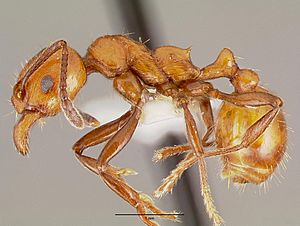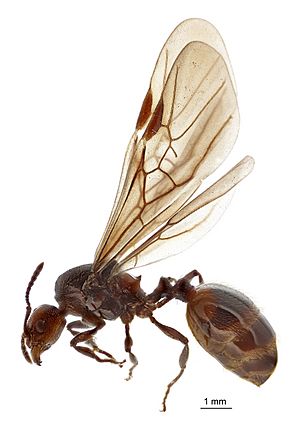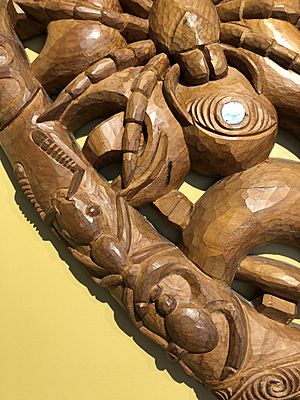Huberia striata facts for kids
Huberia striata is a special type of ant that lives only in New Zealand. It's part of a group of ants called Huberia. These ants are known for their unique features and their role in New Zealand's natural environment.
Quick facts for kids Huberia striata |
|
|---|---|
 |
|
| Huberia striata worker | |
| Scientific classification | |
| Kingdom: | |
| Phylum: | |
| Class: | |
| Order: | |
| Family: | |
| Subfamily: |
Myrmicinae
|
| Genus: | |
| Species: |
H. striata
|
| Binomial name | |
| Huberia striata (Smith, F., 1876)
|
|
| Synonyms | |
|
Huberia striata rufescens Forel, 1892 |
|
Contents
Meet the Striated Ant
Huberia striata is a fascinating ant species. It was first described by a scientist named Frederick Smith in 1876. This ant is special because it is endemic to New Zealand. This means it is found naturally nowhere else in the world.
What Makes Them Special?
Like all ants, Huberia striata belongs to the Insect class. They are part of the Hymenoptera order, which also includes bees and wasps. These ants are known for their unique body structure. Worker ants are usually small. They have strong jaws for carrying food and digging.
Different Ant Roles
Ant colonies are very organized. They have different types of ants, called castes.
- Worker ants are usually female and cannot have babies. They do most of the work. This includes finding food, building the nest, and caring for the young.
- Queen ants are larger females. Their main job is to lay eggs. They are the mother of the entire colony.
- Male ants have wings. Their only job is to mate with a queen from another colony.
Where Do They Live?
Huberia striata ants live in various habitats across New Zealand. They often build their nests in the soil or under rocks. Sometimes they can be found in rotting wood. Their nests are complex networks of tunnels and chambers. These tunnels provide safety and a place to store food.
New Zealand's Unique Environment
New Zealand has many unique plants and animals. Huberia striata plays a part in this special ecosystem. Being endemic means they have adapted perfectly to their home. They are an important part of the local food web.
Ant Life Cycle
The life cycle of Huberia striata is similar to other ants. It starts with an egg.
- Egg: The queen ant lays tiny eggs.
- Larva: The eggs hatch into larvae. These look like small, white grubs. They are fed by the worker ants.
- Pupa: The larva then changes into a pupa. This is a resting stage. During this time, the ant transforms into its adult form.
- Adult: Finally, the adult ant emerges from the pupa. It will then take on its role in the colony.
Reproduction in the Colony
New queen and male ants are born at certain times of the year. They have wings and fly out of the nest. This is called a mating flight. They find mates from other colonies. After mating, the male ants die. The new queen loses her wings and starts a new colony.
Their Role in Nature
Huberia striata ants are very important to their environment. They help in many ways.
- Soil health: Their tunneling helps to aerate the soil. This means they create tiny air pockets. This is good for plant roots.
- Seed dispersal: Some ants help spread plant seeds. They carry seeds back to their nests. Some seeds might sprout there.
- Food source: Ants are also a food source for other animals. Birds, lizards, and other insects might eat them.
By understanding ants like Huberia striata, we learn more about the amazing world of insects. They show us how every creature plays a part in nature.



